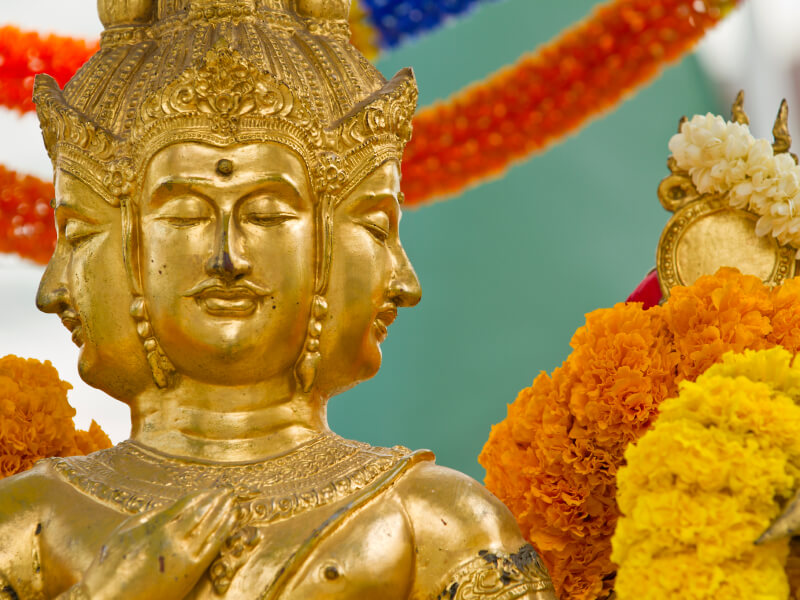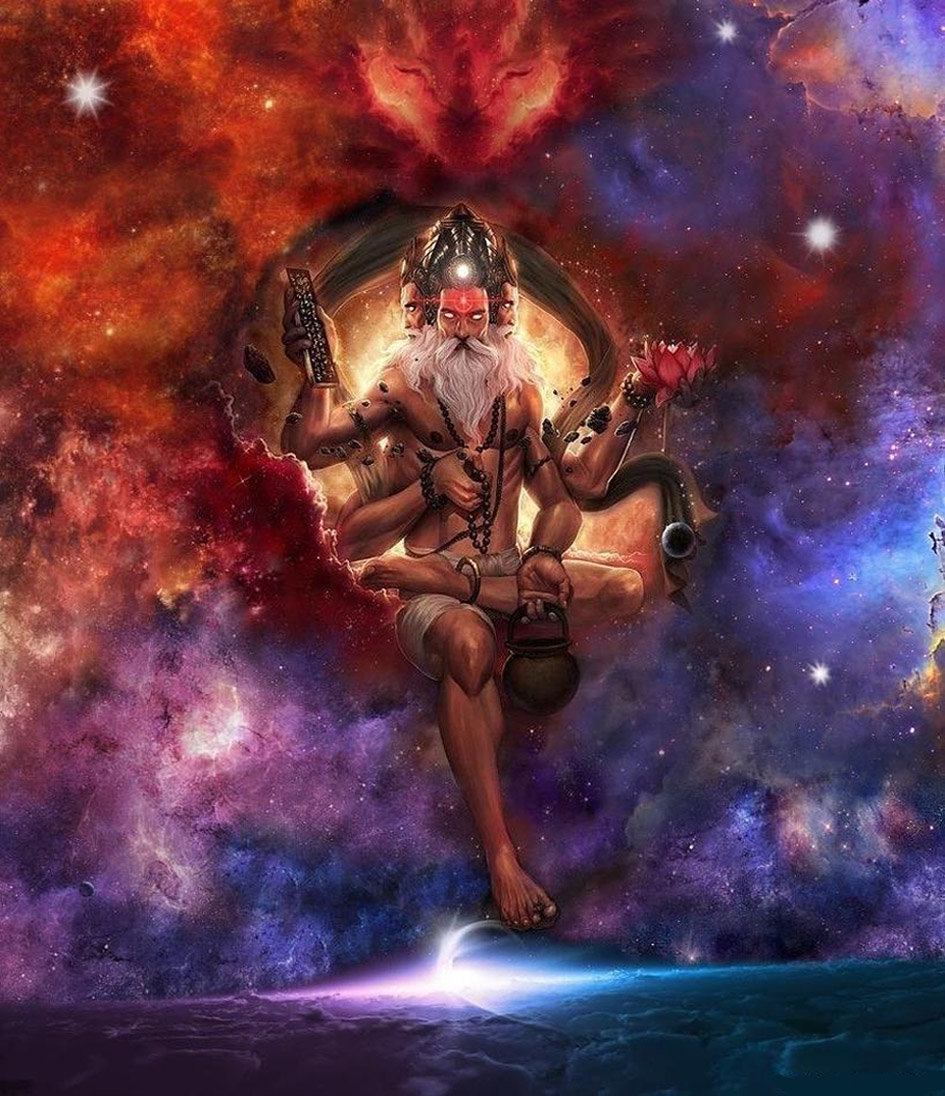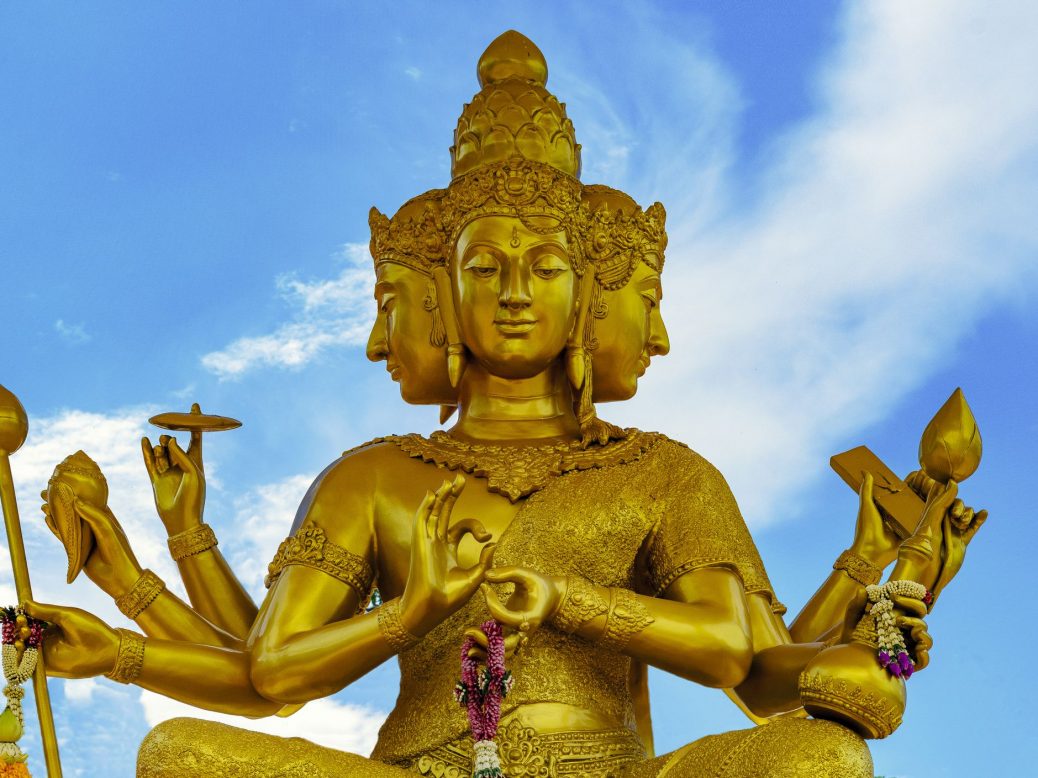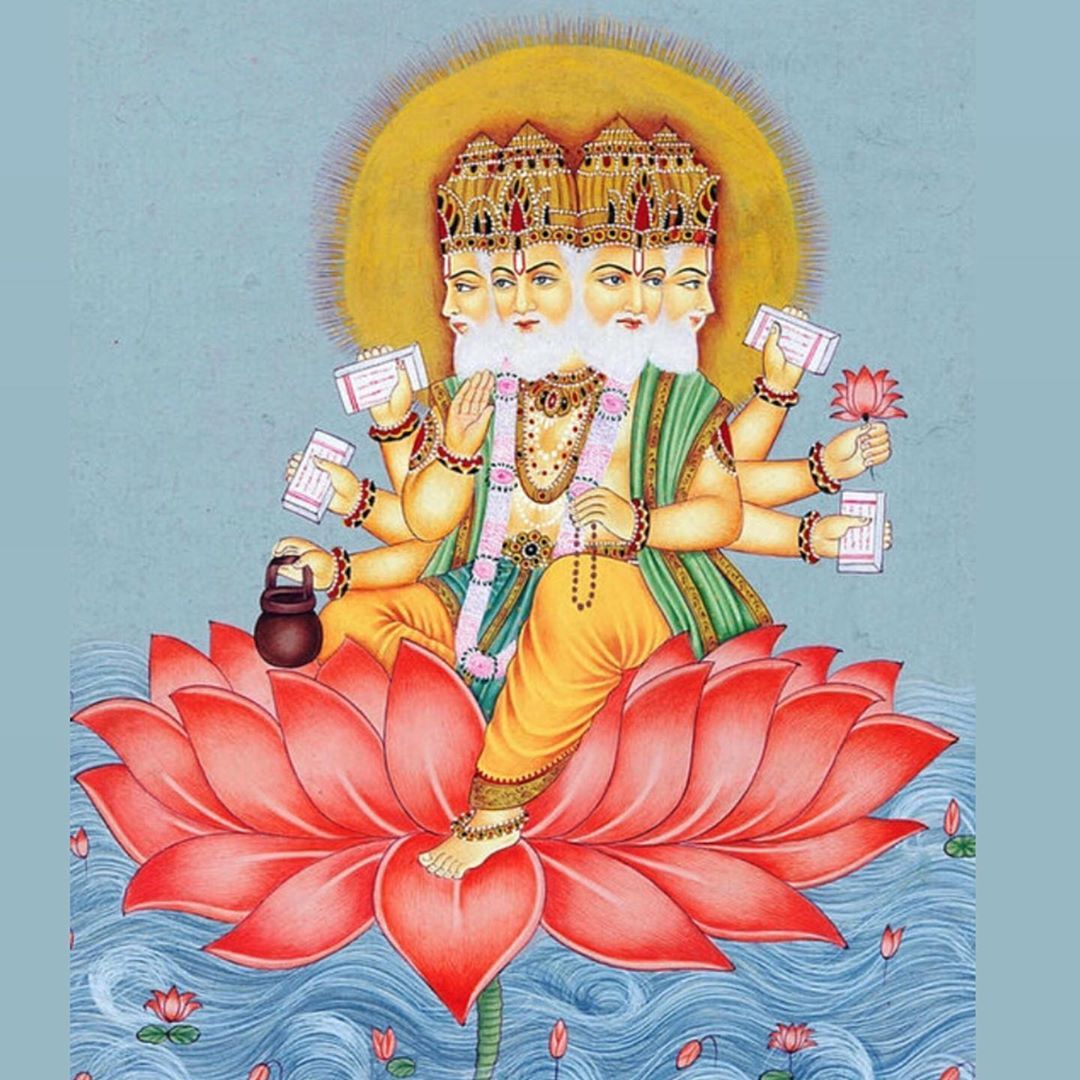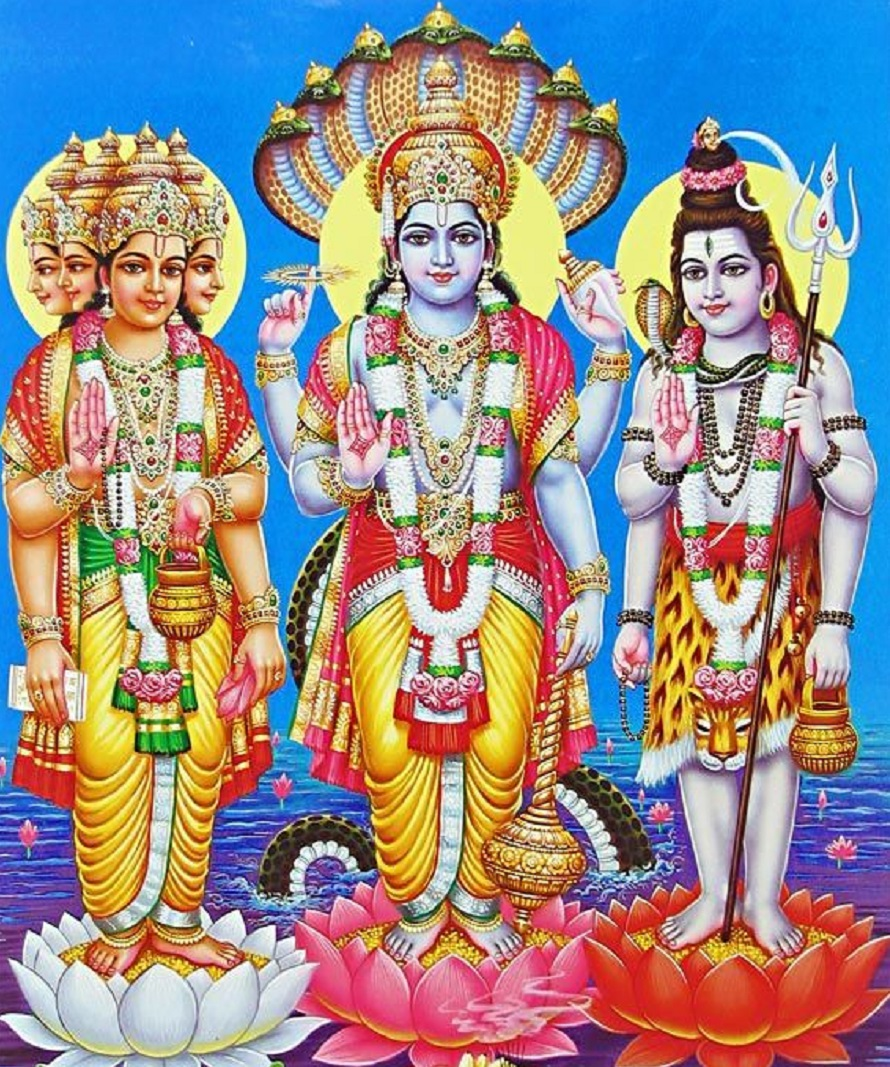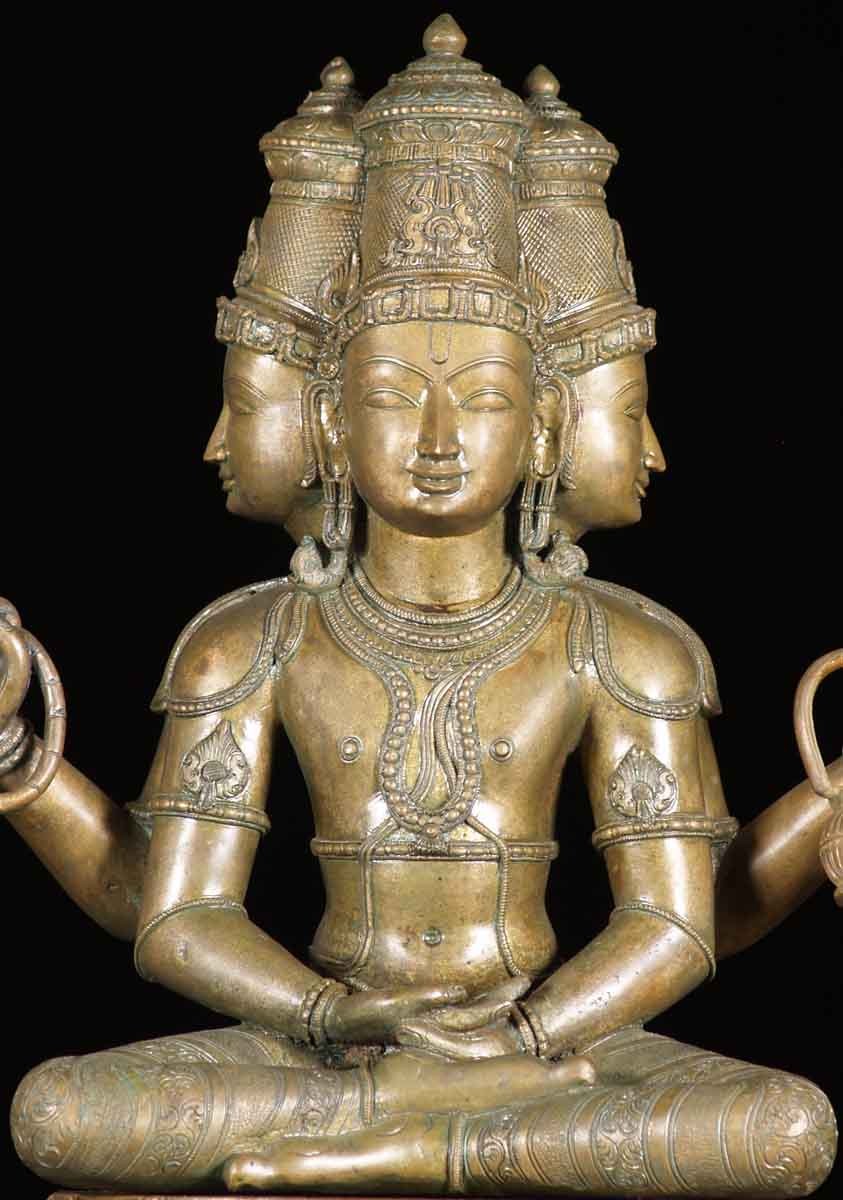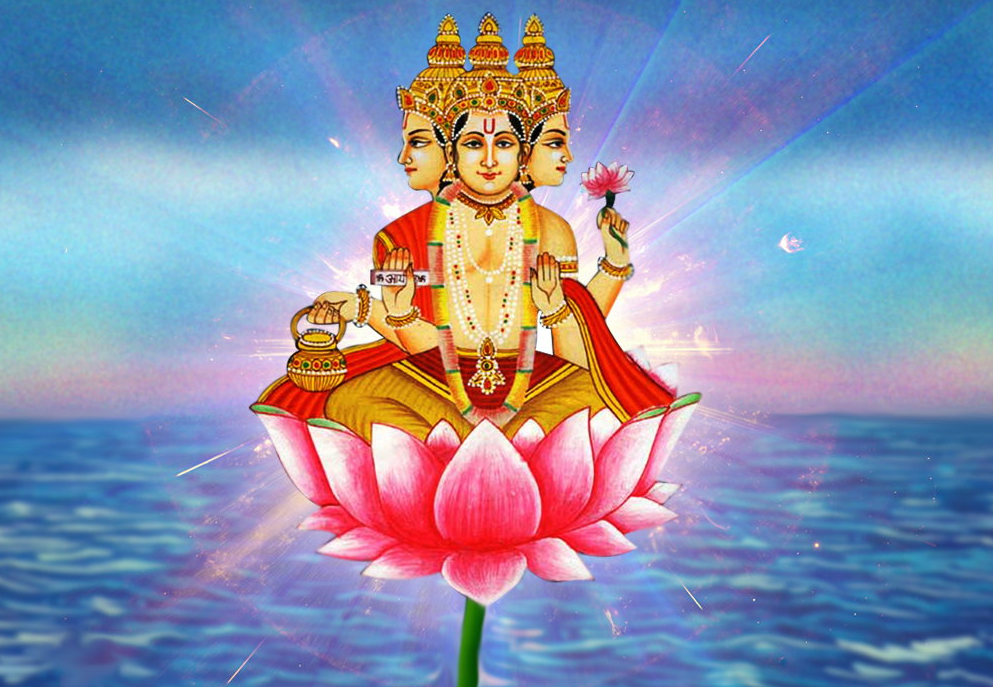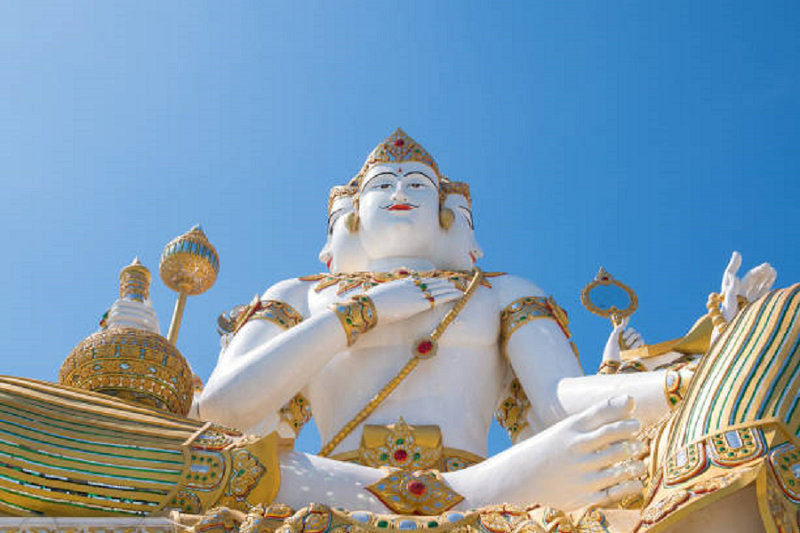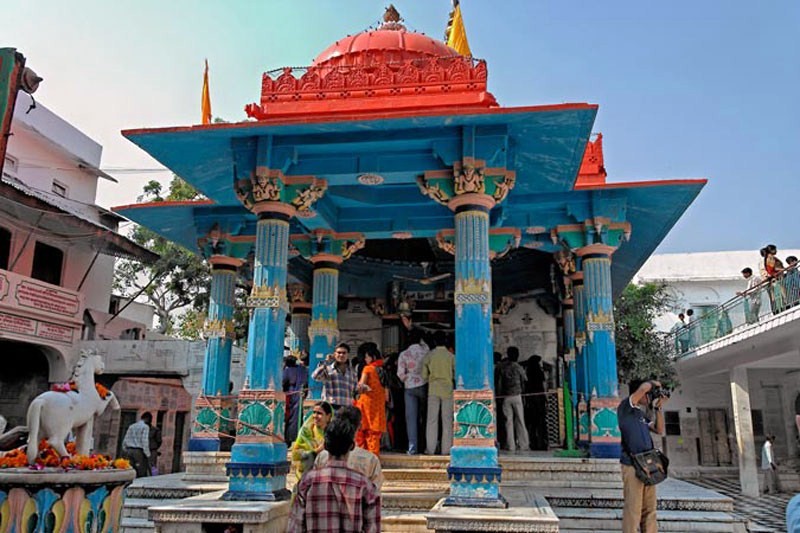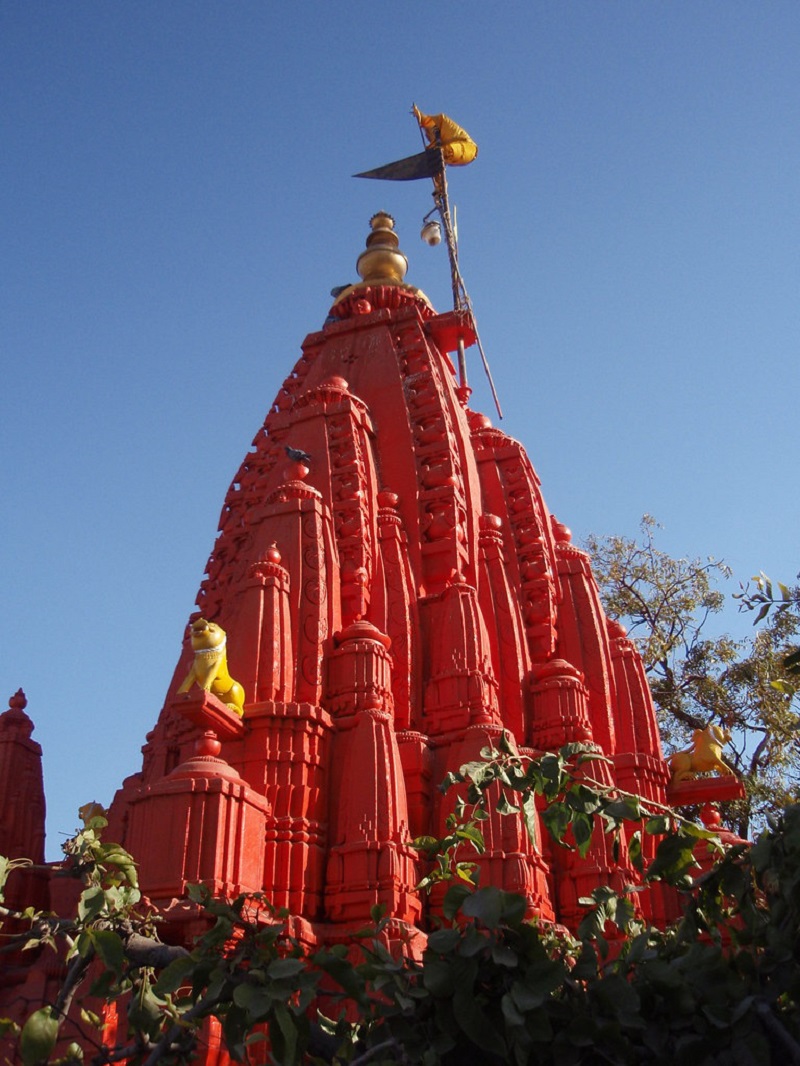Hinduism perceives all creation and its cosmic activity as the work of three fundamental forces symbolized by 3 gods that constitute the Hindu Trinity or «Trimurti» these are: Brahma the creator, Vishnu the sustainer and Shiva the destroyer. In this opportunity, we invite you to know everything related to the God Brahma.

God Brahma, The Creator
Hindu mythology addresses Brahma the omniscient, the source of all that exists, the cause of all forms and events, by various names:
- He is the syllable “Om” – the eka aksharam (single letter).
- Self-born uncreated creator, he is Swayambhu.
- First manifestation of one's existence, is Ahankara.
- Embryo from which the universe originates, is Hiranya Garbha (golden embryo).
- Ball of fire.
- As all creatures are his progeny, he is Prajapati the king of kings.
- Pitamaha the patriarch.
- Vidhi the payer.
- Lokesha the master of the universe.
- Viswakarma the architect of the world.
Origin of the god Brahma
There are numerous accounts of Brahma's origin in the Hindu scriptures, offering divergent versions of his beginnings. According to the widely read and popular Puranas, Brahma was born at the beginning of the universe from the lotus that grows from Vishnu's navel (Consequently, Brahma is sometimes called Nabhija or "navel-born").
Another legend says that Brahma created himself by first creating water. Into the water he deposited a seed which later became the golden egg or Hiranyagarbha. From this golden egg was born Brahma the creator personified, and the remaining materials of the egg expanded to form the Universe (as a result, it is also known as Kanja, or "born in water").
In the Sapatha Brahmana, Brahma is said to have been born from the fusion of the human priesthood with fire, the element that had long been the center of Vedic rituals. This suggests that the historical origins of Brahma are closely related to Vedic sacrifices.
In the Upanishads, Brahma gradually supplants Prajapati (or the "Master of Creatures," the most commonly recognized creator God in the Vedas) as the initial creator, taking on most of Prajapati's characteristics. The Mundaka Upanishad explains that "Brahma arose as the first among the gods, the maker of the universe, the protector of the world." Such descriptions had previously been given to Prajapati in the Vedas.
Characteristics of the god Brahma
Any representation of the god Brahma found in a Hindu temple is depicted as usual with four heads, four profiles, and four arms. The explanation of the four heads is found in the ancient stories of the Puranas, where it is said that when Brahma was creating the universe he also made Shatarupa, a female deity with a hundred beautiful forms.
The god Brahma was instantly enraptured by his creation, and Shatarupa, disturbed by Brahma's persistent presence, began to move in various directions to avoid his gaze on her. However, her attempts to elude Brahma proved futile, as Brahma grew a head so that he could see her better no matter which way he would go.
Brahma grew five heads where each one looked at the four cardinal directions, as well as one above the others. By this point, Lord Shiva had also grown tired of Brahma's antics finding it somewhat disturbing that Brahma had fallen so in love with Shatarupa, who as his creation was equivalent to his own daughter.
To check Brahma's quasi-incestuous advances, Shiva cut off the top of his head. Since the incident, Brahma has turned to the Vedic scriptures in an attempt to repent. Therefore, he is commonly depicted holding the four Vedas (wisdom texts) and each head recites one of them.
The god Brahma is usually depicted with a white beard on each of his faces, illustrating the long duration of his existence since the beginning of time. None of his four arms carry a weapon, which distinguishes him from most other Hindu gods. One of his hands is shown holding a ladle which is associated with the pouring of sacred ghee or oil on a sacrificial pyre, this somewhat indicates Brahma's status as the lord of sacrifices.
In the other hand he holds a pot of water, alternately depicted as a coconut shell containing water. Water is the initial all-encompassing ether, in which the first seeds of creation were sown, and is therefore of great importance. The god Brahma also holds a rosary which he uses to keep track of time. He is usually depicted as sitting on a lotus flower which symbolizes the earth and his color is usually red which represents fire or the sun and his creative power.
Brahma's vehicle (vahana) is the swan. This divine bird is given a virtue called Neera-Ksheera Viveka or the ability to separate mixtures of milk and water into their constituent parts. In the Hindu tradition, this action represents the idea that justice should be administered to all creatures, no matter how complex the situation. Furthermore, this ability to separate water and milk indicates that one must learn to similarly differentiate good from evil, accepting what is valuable and discarding what is worthless.
A legend involving Sarasvati, his main consort, provides an explanation for the virtual lack of worship given to Brahma. This story tells of a great fire sacrifice (or yajna) that was about to take place on Earth with the sage Brahmarishi Bhrigu serving as high priest, it was decided that the greatest of all gods would be made the ruling deity, and Bhrigu set out to find the greatest among the Trinity.
When he reached Brahma, the god was so immersed in the music Sarasvati was playing that he could barely hear Bhrigu's calls. The enraged Bhrigu swiftly cursed Brahma, reciting that no person on Earth would offer him invocations or worship again.
Etymology
The etymology of the word Brahman is the root Bruh with the suffix Manin. The word runs in two genders (neuter and masculine) with different meanings. Brahman in neuter gender means "for Brahman", the Supreme Consciousness, the Absolute Reality, the Supreme Divinity. As far as this refers to the "divinity" that permeates and absorbs this entire universe.
The other word in the masculine gender means the very manifestation of the Absolute Reality in the form of the creator. The depiction of Brahma as an ancient god symbolizes creation without beginning, thus the four faces of him are said to be the birthplace of the four Vedas.
History
In the beginning, Brahma emerged from the cosmic golden egg to subsequently create good and evil, as well as the light and darkness of his own person. He also created the four types: gods, demons, ancestors and men (the first was Manu). The god Brahma then created all living creatures on earth (although in some myths this is attributed to Brahma's son Daksa).
During the course of creation, perhaps in a moment of carelessness, the demons sprouted from Brahma's thigh, leaving his own body to later transform into the night. After the god Brahma created good gods he left his body once more, later to become day. So the demons gain ascension at night and the gods the forces of goodness rule the day.
Subsequently, Brahma created the ancestors and men, abandoning his body again so that they would become twilight and dawn respectively (this creation process is repeated in each eon). Brahma then appointed Shiva to rule over mankind although in later myths, the god Brahma becomes a servant of Shiva.
The creator god Brahma in turn had various consorts, the most important was Sarasvati who after creation gave Brahma: the four Vedas (sacred books of Hinduism), all the branches of knowledge, the 36 Raginis and 6 Ragas of the music, ideas like memory and victory, yoga, religious acts, speech, Sanskrit, and the various units of measurement and time.
Besides Daksa, Brahma had other notable sons including the Seven Sages (of whom Daksa was one), and the four famous Prajapatis (gods):
- kardama
- pancasikha
- voodoo
- Narada, last commissioner between gods and men.
Additionally, the god Brahma was considered the maker of women and death. In the mythological stories told in the Mahabharata, Brahma conceived women as the origin of evil among men:
“A licentious woman is a burning fire… she is the edge of the knife; she is poison, a snake and death, all in one. »
The gods feared that men would become so powerful that they might challenge their reign, so they asked the god Brahma what was the best way to prevent it. His response was to create meaningless women who:
«Eager for sensual pleasures, they will begin to excite men». Then the lord of the gods, the lord created anger as the helper of desire, and all creatures, falling into the power of desire and anger, will begin to attach themselves to women” – Mahabharata in Hindu Myths, 36.
In another story, Brahma's first wife is also death, the evil force that brings balance to the universe and ensures that it is not overstepped. The figure of death is picturesquely described in the Mahabharata as:
«a dark woman, dressed in red clothes. Her eyes, hands and feet had red hues, she was adorned with divine earrings and ornaments »and is charged with the task of« destroying all creatures, imbeciles and scholars »without exception – Mahabharata in Hindu Myths, 40.
Death sobbed and begged the god Brahma to release her from this horrible task, but Brahma remained unmoved and sent her to do her duty. At first, Death continued his protests by performing various extraordinary acts of asceticism such as standing in the water in complete silence for 8.000 years and standing on top of the Himalayan mountains for 8.000 million years, but Brahma was not swayed.
So death, still sobbing, did his duty bringing endless night to all things when his time came and his tears fell to earth and turned into sickness. Thus, through the work of death, the distinction between mortals and gods was preserved forever.
Union between Brahma, Shiva and Vishnu
Brahma-Vishnu-Shiva is the Hindu trinity, also called trimurti. The Sublime Spirit or Universal Truth, called Brahman, is formed in three personifications each with a corresponding cosmic function: Brahma (the creator), Vishnu (the preserver) and Shiva (the transformer/destroyer). Because Hinduism is a collection of different traditions and beliefs, scholars believe that Brahma-Vishnu-Shiva was an attempt to reconcile the doctrine of Brahman with different approaches to the Divine.
Of the three incarnations of Brahman, Shiva has a special place in traditional yogic practices as he is considered the main yogi or adiyodi. Shiva also symbolizes the balance of awareness and bliss, and the calming effects of yoga practices in general. Oneness with Brahman, personified as the trimurti, is the ultimate goal in yoga philosophy and practice. Today Brahma-Vishnu-Shiva as trimurti is rarely worshipped.
Instead, Hindus typically worship one of the three as the highest deity and regard the others as incarnations of their highest god. As a model, Vaishnavism holds that Vishnu is the superior god, while Shaivism believes that Shiva is superior. Brahma by comparison has relatively few devotees as a superior deity. In ancient texts, the three gods symbolize earth, water and fire:
- Brahma: represents the earth. He is the originating and creative power of all life. One story claims that he is the son of Brahman, while another says that he created himself from water and seed.
- Vishnu: represents water, which symbolizes its role as a sustainer of life. He is the protective side of Brahman, known for upholding goodness and creation, and identifies with his incarnations: Krishna and Rama.
- Shiva: represents fire and is identified as the destructive power of the trimurti. However, he is also seen as a positive force that cleanses and destroys evil, paving the way for a new creation and a new beginning.
The religion of Brahmanism
Brahman as the Ultimate Reality, the Universal Intellect that is infinite without beginning, middle and end is a metaphysical concept that forms the basis of Brahmanism. Brahmanism is considered to be the predecessor of Hinduism. So Brahmanism is the central theme and the belief of the Vedic followers, their thoughts and philosophical concept give rise to the primary and socio-religious belief and conduct in Hinduism.
Since the inference and perception of Brahman was introduced by the Rishis, who later became staunch followers of Brahmanism, they were considered by some to belong to the priestly caste and were called Brahmins. These duplicated the ideology through teachings and ritual performance, and thus Brahmanism came to be practiced with vigor and unflinching determination.
It is also said that Brahmanism as claimed by some researchers got its name from the Brahmins, who performed the Vedic rituals. Furthermore, a Brahman priest is one who is always absorbed in the thoughts of the eternal Brahman. Brahmanism, however, remains the most sought after ideology that baffles the interpretation skills of the wisest preceptors and top scholars and to this day remains an inexhaustible mystery.
The central concepts of Brahmanism are significantly aligned with metaphysics, questioning what is really real, the validity of time, of being, of consciousness, and the origin and basis of all existence. Many scholars, such as archaeologists, geologists, hydrologists and philologists, have taken refuge in the writings of the Vedas, especially in the concept of Brahman, since it is directly related to humans and their origin.
Brahman as the all-pervading, all-eternal, and main cause of "everything that has movement and has no movement", forms an important acceptance in Brahmanism. It is based on the belief that everything that ever existed, exists now, and will exist is a tiny event in the eternal universal reality, called Brahman.
The Atman, the soul, is the second most important concept in Brahmanism. The Atman is considered to be the source of all vitality among humans. The soul of a living being is considered to be the same as Brahman itself, leading to the belief that a human who embodies the soul is none other than Brahman and has all the attributes of Brahman.
The soul, thus identified as identical to the all-pervading Supreme Soul, forms a significant belief in Brahmanism. The Supreme Soul, which is not yet born and is the reason for everyone's birth, forms the underlying principle of Brahmanism, which expanded following the inference of Brahman.
A soul is considered to be the same as the Supreme Soul, which is nothing more than Brahman. This belief shows the influence of Brahmanism on Buddhism, Jainism and Hinduism. Hinduism today is considered nothing less than the progeny or a branch of Brahmanism, as the Hindus received their name from the Indus River, on whose banks the Vedas were practiced by the Aryans. Therefore, the Hindus who followed the Vedas and their Brahman belief were seen as the early proponents of Hinduism.
Brahmanism and Buddhism
Buddhism has been considered to be an offshoot of Brahmanism in terms of its main ideology and beliefs, but they have adjusted it to their own interpretations. It is very likely that someone who follows Brahmanism unquestionably believes in the concept of rebirth of humans because the soul embodied by human flesh would soon take refuge in a new body, a new avatar, to fulfill its unfulfilled desires.
Buddhism, on the other hand, does not believe in the concept of rebirth, but has elucidated Brahmanism to the relief that everything else in the universe is null except Brahman, which is the only one that exists and is eternal. Buddhists also challenge and reject the belief in a human soul, stating that there is an undeniable living soul, and humans do not embody a soul but are filled with suffering, which constitutes their impermanence.
Vedic literature
Veda, (Sanskrit: "Knowledge") is a collection of poems or hymns composed in archaic Sanskrit by Indo-European-speaking societies that inhabited northwestern India in the second millennium BC. C. No definite date can be attributed to the composition of the Vedas, but the period of about 1500-1200 B.C. C. is acceptable to most scholars.
The hymns formed a liturgical body that, in part, grew around the ritual and sacrifice of the soma and were recited or sung during the rituals. They praised a wide pantheon of gods, some of whom personify natural and cosmic phenomena, such as fire (Agni), the Sun (Surya and Savitri), dawn (Ushas a goddess), storms (the Rudras) and the rain (Indra). ), while others represent abstract qualities such as friendship (Mitra), moral authority (Varuna), kingship (Indra), and speech (Vach a goddess).
The main compendium, or Samhita, of such poems from which the hotri ("reciter") drew the material for his recitations, is the Rigveda ("Knowledge of Verses"). Sacred formulas known as mantras were recited by the adhvaryu, the priest responsible for setting the sacrificial fire and carrying out the ceremony. Those mantras and verses were incorporated into the Samhita known as Yajurveda ("Knowledge of Sacrifice").
A third group of priests headed by the udgatri (chanter), performed melodic recitations linked to verses that were almost entirely removed from the Rigveda but were organized as a separate Samhita, the Samaveda ("Knowledge of chants"). Those three Rig Vedas, Yajur and Sama, were known as trayi-vidya (“threefold knowledge”).
A fourth compendium of hymns, magic spells, and incantations is conceived as the Atharvaveda ("Knowledge of the Fire Priest"), which includes various local traditions and remains partly outside the Vedic sacrifice. A few centuries later, perhaps around 900 BC. C., the Brahmanas were composed as glosses on the Vedas, which contained many myths and explanations of rituals.
The Brahmanas were followed by other texts, the Aranyakas ("Forest Books") and Upanishads, which took philosophical discussions in new directions, invoking a doctrine of monism and freedom (moksha, literally "liberation") from the cycle of death and rebirth ( samsarah).
The entire body of Vedic literature: the Samhitas, the Brahmanas, the Aranyakas and the Upanishads, is considered to be Shruti ("That which is heard"), the product of divine revelation. All literature appears to have been preserved orally (although there may be early manuscripts to aid memory). To this day several of these works, particularly the three oldest Vedas, are recited with subtleties of intonation and rhythm that have been passed down orally since the earliest days of the Vedic religion in India.
Post-Vedic, Epics and Puranas
Towards the end of the Vedic period and more or less simultaneously with the production of the major Upanishads, concise, technical and usually aphoristic texts were written on various topics related to the proper and timely performance of Vedic sacrificial rituals. These were eventually labeled as Vedangas ("Studies ancillary to the Veda"). The concern with the liturgy gave rise to academic disciplines, also called Vedangas, which were part of Vedic scholarship. There were six such fields:
- Shiksa (instruction), which explains the proper articulation and enunciation of Vedic passages.
- Chandas (metric), of which only a late representative remains.
- Vyakarana (analysis and derivation), in which language is described grammatically.
- Nirukta (lexicon), which analyzes and defines difficult words.
- Jyotisa (luminaries), a system of astronomy and astrology used to set the proper times for rituals.
- Kalpa (execution mode), which studies the correct ways of performing the ritual.
Among the texts inspired by the Vedas are the Dharma-sutras, or "manuals on dharma," which contain rules of conduct and rituals as practiced in various Vedic schools. Its main contents deal with the duties of people in different stages of life, or ashramas (studies, home, retirement and resignation); dietary regulations; offenses and expiations; and the rights and duties of kings.
They also discuss purification rites, funerary ceremonies, forms of hospitality and daily obligations, and even mention legal matters. The most important of these texts are the Gautama, Baudhayana, and Apastamba sutras. Although the direct relationship is not clear, the content of these works was further developed in the more systematic Dharma-shastras, which in turn became the basis of Hindu law.
Brahma sutras, a text of Hinduism
The Brahmasutra, known as the Sariraka Sutra or Sariraka Mimamsa or Uttara Mimamsa or Bhikshu Sutra of Badarayana, is one of the three texts that are collectively called the Prasthana Traya, the other two being the Upanishads and the Bhagavad Gita. The Badarayana text reveals that before him there were several teachers, such as Asmarathya, Audulomi and Kasakritsna, who understood the meaning of the Upanishads in different ways.
It must be admitted that, in the current state of knowledge, the "heart of the Sutrakara" is difficult to understand. This explains why there have been innumerable commentaries on the Brahmasutra, the most prominent being those by Sankara, Ramanuja, Madhva, Nimbarka, and Vallabha.
These commentators differ even in the actual number of Sutras or aphorisms. For example, while Sankara puts the figure at 555, Ramanuja puts it at 545. This is because these preceptors differ on what constitutes a particular sutra: what is one sutra for one Acharya is two for another, or vice versa.
The word "sutra" literally means the thread that unites the various Vedantic teachings into a logical and self-consistent whole. Sankara imparts a poetic undertone when he says that these sutras string the flowers in the form of Upanishad passages (vedanta vakyakusuma).
Brahma samhita, a text of the god brahma
The Brahma Samita (Praises of Brahma) is a text of the Pancaratra (the Vaishnava Agamas offered for the worship of Lord Narayana); made up of prayer verses uttered by Lord Brahma glorifying the Supreme Lord Shri Krishna (Govinda) at the beginning of The Creation. The god Brahma, who is the first disciple of the succession of disciples initiated by Lord Shri Krishna, is given the task of material creation and checking the way of passion, being created by the god Shri Krishna, through of your navel.
Throughout Kaliyuga, the current age of dispute and hypocrisy, the Brahma Samhita was relatively unknown, until the appearance of Lord Chaitanya, who only retrieved chapter 5 of the entire text. As a result, chapter 5 is the chapter that has been read, studied, and sung about ever since. Spiritual initiation ceremonies often begin by chanting the fifth chapter of the Brahma Samhita in unison.
The Brahma Samhita presents methods of devotional service. Brahma Samhita explains the Garbhodakasayi Visnu, the origin of the Gayatri Mantra, the form of Govinda and his transcendental position and abode, living entities, Goddess Durga, the meaning of austerity, the five elements, and the vision of transcendental love that allows one to see to Lord Shri Krishna.
Brahma vihara as meditation
Brahma vihara is a term that refers to the four Buddhist virtues and meditative application. Its origin is generated from the Pali words, brahma, which denotes "god" or "divine"; and vihara, which means "dwelling." The brahma vihara are also known as the four appamanna, or "immeasurable," and as the four sublime states.
The Buddhist yogi practices these sublime states of brahma vihara through a meditation technique called brahma vihara-bhavana with the goal of achieving jhana (concentration or the full meditative state) and ultimately the state of enlightenment known as nirvana. The brahma viharas include:
- Upekkha – equanimity that is rooted in insight. It is detachment, serenity, and a balanced and calm mind in which everyone is treated fairly.
- Metta – loving kindness that actively shows goodwill towards everyone.
- Karuna – compassion in which the Buddhist identifies the suffering of others as his own.
- Mudita – empathetic joy in which the Buddhist rejoices at the happiness and joy of others, even though he or she has not participated in creating that happiness.
These same four concepts can be found in yoga and in Hindu philosophy. Patanjali discussed these as states of mind in the Yoga Sutras.
The practice of Brahma mudra
Brahma mudra is a hand gesture used in both yoga asana, meditation, and the constant application of pranayama that is valued for both its symbolic and healing characteristics. Brahma is the name of the Hindu creator god and in Sanskrit it translates as "divine", "sacred" or "supreme spirit", while Mudra means "gesture" or "seal".
This is usually practiced in a comfortable sitting position, such as vajrasana or padmasana. Both hands form fists with fingers wrapped around thumbs, palms facing skyward, and both hands pressed together at the knuckles. The hands rest gently against the pubic bone.
Sometimes called "the gesture of all-pervasive awareness," Brahma mudra helps promote full breathing during pranayama. Because this mudra, and mudras in general, are believed to affect the flow of life force energy (prana) throughout the body, it calms the mind and energizes the body. Brahma mudra is also believed to have these benefits:
- Increase concentration.
- Release negative energy.
- Eliminate toxins.
- It helps the yogi to reach a higher meditative state.
Temples
The Pushkar temple may be the most popular in the world offered to worship the god Brahma, but it is certainly not the only one. However, it is the oldest temple offered to this Hindu god. Legend has it that Brahma, compared to other gods, was much more forgiving and blessed his devotees wholeheartedly, so there were several cases where he blessed the devotees with blessings without considering the repercussions of the blessings from him. .
It is said that he blessed demons from Hiranyakashipu and Mahishasur to Ravana, causing them to torment people and various gods as well. Because of this Vishu and Shiva would have to take control of situations and kill the demons with their various avatars. As Brahma continued to be indulgent, people stopped worshiping him and instead offered prayers to Vishnu and Shiva.
Another legend says that Brahma created a goddess Shatarupa with a hundred forms. As soon as she was created, Brahma took a fancy to her and followed her everywhere due to her enchantment towards her. However, she tried to avoid it for as long as possible. But Brahma was firm enough to give himself five heads, one in each direction – north, south, east and west and the fifth head above the others, intending to watch her wherever she went without ever losing sight of her.
As Shatarupa was considered the daughter of Brahma, Shiva cut off Brahma's fifth head as an incestuous relationship was not considered appropriate. Since then, Brahma is believed to be the ignored deity among the trimurti: Brahma, Vishnu and Shiva.
However, over time it is said that the god Brahma sought repentance and forgiveness for such an action, and that is why several other temples were built and established to worship the creator god, Brahma. Here are some of the most revered Brahma temples in India:
Brahma Temple, Pushkar
Located near Pushkar Lake in the Ajmer district of Rajasthan, the Brahma temple is one of the most visited Brahma temples in India. In the Hindu month of Kartik (November), followers of this god who come to the temple take a dip in the lake offering prayers to the deity.
Asotra Brahma Temple, Barmer
The Asotra Temple is situated in the Barmer district of Rajasthan, this is another temple mainly dedicated to Brahma. It was established by the Rajpurohits of the people and is built with stone from Jaisalmer and Jodhpur. However, the idol of the deity is made of marble.
Adi Brahma Temple, Khokhan – Kullu Valley
The Adi Brahma Temple is situated in the Khokhan area of the Kullu Valley. Legend has it that the temple was worshiped by people from both the Mandi and Kullu districts. However, when the two kingdoms were divided, a replica was built on the other side, in Mandi, and devotees had to limit themselves to visiting the temple that belonged to the limits of the kingdom.
Brahma Temple, Kumbakonam
It is believed that Brahma was proud of his gift of creation to the point that he boasted that he was better than Shiva and Vishnu in the art of creation. This caused Vishnu to create a ghost that scared Brahma. Terrified, he came to Vishnu for help, having apologized for his immodesty. Vishnu then asked Brahma that he would observe penance on Earth to redeem himself.
It is believed that Brahma chose the Kumbakonam to meditate on. Pleased by Brahma's attempts, Vishnu accepted his apology and restored his knowledge and status among the gods.
Brahma Karmali Mandir Temple, Panaji
The Brahma Karmali temple is located about seven kilometers from Valpoi and about 60 kilometers from Panaji. Although the temple is not that old, the idol is believed to date from around the XNUMXth century. It is definitely the only temple in Goa, dedicated to the god Brahma. The black stone statue of Brahma placed in the temple is said to have been brought to Carambolim, Goa in the XNUMXth century by a large part of the devotees who escaped the religious intolerance imposed by the Portuguese.
Brahmapureeswarar Temple, Thirupattur
Legend has it that Shiva's consort, Goddess Parvathi, once mistook Brahma for Shiva. This angered Shiva and he cut off Brahma's head and cursed him so that the worshipers of him would forget him and stripped him of all his powers. Soon, Brahma's pride crumbled and he begged for forgiveness.
However, the enraged Shiva was not ready to accept his apology. To repair all that he had done wrong, Brahma undertook a pilgrimage. On his journey, he reached Thirupattur, where he installed 12 Shiva lingas and worshiped Shiva there. Moved by his attempts to redeem himself, Shiva appeared in front of Brahma, relieved him of the curse and restored all of his powers. Shiva then blessed Brahma and granted him sanctuary in the temple, and Brahma has been the deity of the temple ever since.
Why is the god Brahma not so revered?
There are a number of stories in Hindu mythology that point to why he is rarely worshiped, here are two of them:
The first is that Brahma created a woman to help him with his work of creation, she was called Shatarupa. She was so beautiful that Brahma took a fancy to her, and looked at her wherever she went. This caused him great embarrassment and Shatarupa tried to look away from her. But in every direction she moved, Brahma sprouted a head to watch until he had grown four. Finally, Shatarupa got so frustrated that she jumped up to try and avoid her gaze. Brahma, in her obsession, sprouted a fifth head on top of everything.
Other texts mention that Shatarupa continued to transform into various beings, until becoming all creatures on earth to avoid Brahma. However, he changed her form to the male version of what she was and thus all the animal communities of the world were created. Lord Shiva admonished Brahma for displaying incestuous behavior and cut off his fifth head for "impious" behavior.
Since Brahma had distracted his reason from the soul by moving towards the whims of the flesh, Shiva's curse was that people should not worship Brahma. So as a way of repentance, it is related that Brahma has been continuously reciting the four Vedas ever since, one from each of his four heads.
A second belief as to why Brahma is not revered or honored, and a more sympathetic one, is that Brahma's role as creator has ended. Leaving to Vishnu the job of taking care of the world and to Shiva to continue his passage of cosmic resurrection.
Differences between Brahma, Brahman, Brahmans and Brahmana
To understand the differences between these terms, it is important to know the definition of each one, which is presented below:
- Brahma: he is the creator god of the cosmos and of everything, this is part of the Trimurti, the superior Hindu gods that represent: Brahma (creation), Vishnu (preservation) and Shiva (catastrophe).
- Brahman: it is the Supreme and Indestructible Spirit, it is present in each atom of creation, remaining there as a spectator, without being affected by it. The soul of every living being is part of Brahman.
- Brahmins: they are the congregation from which the Hindu priests come, who have the responsibility of imparting the teaching and sustaining the knowledge of the sacred texts.
- brahmana: the term is used to mention the sacred writings of India that were written in Vedic Sanskrit and correspond to a period that passed between 900 a. C. and 500 a. C. They are part of a precious tradition of the Hindu people.
Mantras of the god Brahma
A mantra is a sacred word, sound, or phrase, often in Sanskrit, recited within a wide variety of religious and spiritual traditions such as Hinduism, Buddhism, and yoga. The word mantra is derived from two Sanskrit roots: manas meaning "mind" and tra meaning "tool." As such, mantras are considered "thinking tools," used as a means of harnessing and focusing the mind.
This can be understood as any sound, word or phrase that modifies consciousness through meaning, tone, rhythm or physical vibration. When sung with devotion, certain expressions are believed to create powerful vibrations in the body and mind, allowing deep states of meditation. Traditionally, mantras are believed to have spiritual and psychological powers, each with its own particular intent and meaning behind it.
Mantras can be pronounced in repetitions or intoned with melody. The repetition of a mantra can be used to awaken higher states of consciousness, to harness the power of intentions, to manifest positive affirmations, and to enter deeper states of consciousness. The mantra of the god Brahma in Sanskrit is:
"Om Namo Rajo Jushei Sristau
Sthithou Sattwa Mayayacha
Tamo Mayaya Sam-harinei
Vishwa rūpayā Vedhasei
Om Brahmanei Namaha»
Whose interpretation is: «Om is the name of Him, who created this cosmos with its three gunas (characteristics of nature: positive, negative and inactive), who gave form to all things and who is universal. He is Brahma, whom I respectfully greet."
If you found this article about the God Brahma interesting, we invite you to enjoy these others:
